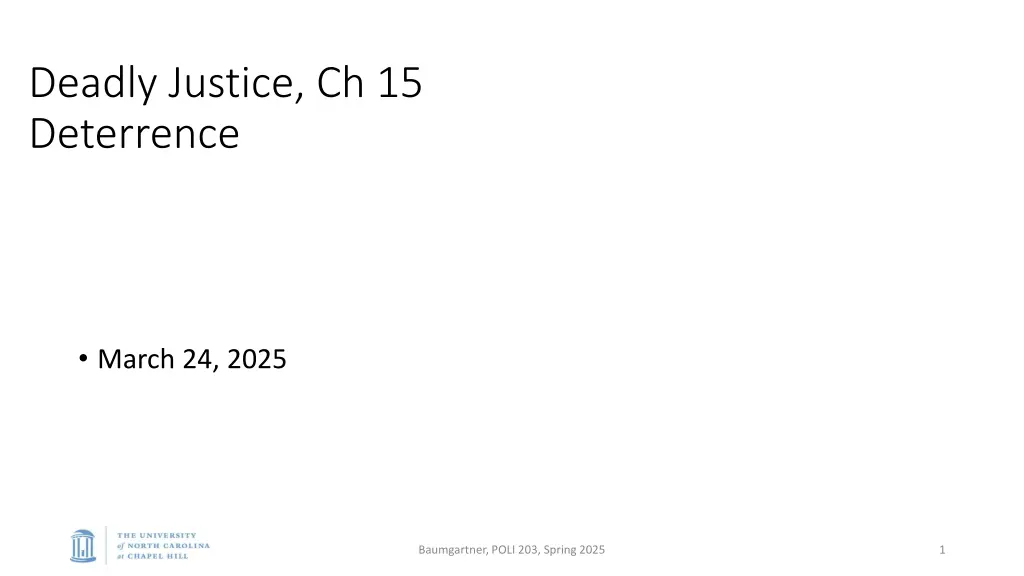
Capital Punishment Deterrence Studies and Controversies
Explore the historical use of deterrence in Furman and Gregg cases, along with studies on the effectiveness of capital punishment in preventing future homicides. Delve into the controversies surrounding the moral implications and uncertainties of the deterrent effect of executions, as discussed in the Baumgartner POLI 203 class in spring 2025.
Uploaded on | 0 Views
Download Presentation

Please find below an Image/Link to download the presentation.
The content on the website is provided AS IS for your information and personal use only. It may not be sold, licensed, or shared on other websites without obtaining consent from the author. If you encounter any issues during the download, it is possible that the publisher has removed the file from their server.
You are allowed to download the files provided on this website for personal or commercial use, subject to the condition that they are used lawfully. All files are the property of their respective owners.
The content on the website is provided AS IS for your information and personal use only. It may not be sold, licensed, or shared on other websites without obtaining consent from the author.
E N D
Presentation Transcript
Deadly Justice, Ch 15 Deterrence March 24, 2025 Baumgartner, POLI 203, Spring 2025 1
Deterrence How it was used in Furman and Gregg Evidence and studies Where we stand today on deterrence Public opinion on deterrence Baumgartner, POLI 203, Spring 2025 2
Furman v. Gregg Furman: The lack of deterrent value was laid out as a reason to abolish It can t deter if it is used extremely rarely on a randomly selected handful But in 1975, in the midst of a rise in crime, Isaac Ehrlich published a study in the American Economic Review Price theory raise the price, demand goes down Here: the object being purchased is murder. Raise the price of murder, demand goes down. Homicides from 1933 through 1969 Clearance rate: 89 percent Percent of those charged who are convicted: 43 percent Executions as a percent of previous year s convictions: 3 percent Controls: labor force participation, unemployment, number of young men in the population, income, time trend, percent nonwhite in the population, population size, government spending, police spending. (Think about this study ) Result: 7 or 8 homicides prevented, BUT, significant only at the 90 percent level, caveats Take-home for the press / advocacy world: Each execution saves 8 lives!!! Baumgartner, POLI 203, Spring 2025 3
Controversies Social scientists argued back and forth about this. Ehrlich s study was cited by the US Solicitor General (Robert Bork) in his argument before the USSC in Gregg v. Georgia. Do we have a moral requirement to execute those who kill? According to Ehrlich, each death sentence prevents 8 future homicides Problem is in evaluating the evidence. Note: Ehrlich s study was death v. no punishment at all, not death v. LWOP. Baumgartner, POLI 203, Spring 2025 4
Model Uncertainty and the Deterrent Effect of Capital Punishment (2008) All previous estimates from the literature on how many lives are saved by one execution Note: it looks just like a random bell curve. Note: it has a huge variability. Note: Lots of estimates are negative: what s the morality of that? Each execution leads to more violence? Baumgartner, POLI 203, Spring 2025 5
National Academy of Sciences review NAS brought together a committee to review the issue 2002 report, then updated in 2014 Conclusion: studies on this topic are not informative The science on this question is clear: we don t know. But note that virtually none of the studies have been psychologically reasonable: from the perspective of the potential killer, do we really think they are considering this? Baumgartner, POLI 203, Spring 2025 6
Public Opinion on Deterrence People tend to believe in deterrence, or used to. Trend is sharply downward over time; see Gallup poll results: 1985, 62-32 yes. 2011, 32-64 no. People do cite deterrence as a reason to support or oppose. Retribution, deterrence often the most common pro-DP arguments Decline in belief in the deterrence value is part of the explanation for the decline in DP opinion generally LWOP, another form of the death penalty, has undercut the deterrence argument: which would deter more? 50 years in a cage, until you die of old age, or a rapid execution? Baumgartner, POLI 203, Spring 2025 7
The strange argument about deterrence The rational murderer Calculate the benefit of the crime Calculate the odds of being captured by the police x the odds of being sentenced to death x the odds of that sentence being carried out, assign values to these outcomes Compare the cost and the benefit, then act accordingly. Note most models relate to the odds of being caught at all, not being caught then subject to this v. that punishment, so they are not even good approximations of the murderer s calculation . More typical murderers Mentally deranged, either permanently or at the time of the crime Strung out on drugs or alcohol or both Completely unaware, as you were before this class started, about the odds of various punishments, given a homicide. Baumgartner, POLI 203, Spring 2025 8
Lets say deterrence was indeed a thing Police clearance rates are more important: What s the odds of getting caught in the first place? Comparison should be to the next available punishment: LWOP It s not even clear that most individuals, if they thought about it, would find a death sentence worse than LWOP Also note no one ever paid attention to the issue of most death sentences being overturned, and only a few carried out. So this literature is a Big Mess, really based on some ideological wishful thinking, or just assuming that there must be deterrence, and the harsher the punishment, the more the deterrence. But it s more complicated than that. Baumgartner, POLI 203, Spring 2025 9
